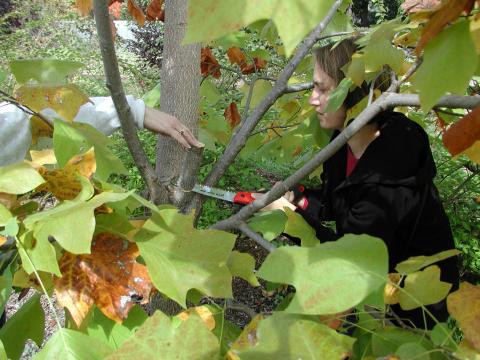Growing a Healthier Community Forest in Kansas City Metro
Photo Credit: Lynn Loughary
Thursday, October 25, 2018
Guest post from Kansas Forest Service in coordination with the Western Urban and Community Forestry Network's #HealthyTreesHealthyLives social media campaign. Explore the hashtag #HealthyTreesHealthyLives on social media to learn more.
 Over the years, Kansas has experienced the negative impacts of insects, disease, major storms and severe weather events. Following a particularly severe ice storm in 2002, individuals from the Kansas Forest Service (KFS), Missouri Department of Conservation, non-profit organizations, and corporate entities banded together to form the Right Tree in the Right Place Coalition to disseminate proper tree care information via broadcast, print, and electronic media sources to people affected by the storm in the Kansas City metropolitan area. After a while, it became clear that it wasn’t enough to only provide information, it was time to create a non-profit forestry organization that could help metro communities care for their young trees, teach residents how to properly plant and care for trees, and advocate for a healthy community forest.
Over the years, Kansas has experienced the negative impacts of insects, disease, major storms and severe weather events. Following a particularly severe ice storm in 2002, individuals from the Kansas Forest Service (KFS), Missouri Department of Conservation, non-profit organizations, and corporate entities banded together to form the Right Tree in the Right Place Coalition to disseminate proper tree care information via broadcast, print, and electronic media sources to people affected by the storm in the Kansas City metropolitan area. After a while, it became clear that it wasn’t enough to only provide information, it was time to create a non-profit forestry organization that could help metro communities care for their young trees, teach residents how to properly plant and care for trees, and advocate for a healthy community forest.In 2005, Heartland Tree Alliance (HTA), an affiliate of Bridging the Gap, emerged to fill that need. Driven by the motto “Healthy People Need Healthy Trees”, HTA volunteers have donated 13,000+ hours of time, enabling the organization to plant 17,874 trees, prune 3,264 trees, and provide maintenance assistance by mulching or removing tree stakes to another 2,527 trees.
Led by a steering committee and three full-time employees, HTA trains and engages the volunteers that help cities plant, prune, mulch, and care for young trees. To ensure they are properly trained, volunteers attend a TreeKeeper course held in Missouri and Kansas each year or attend a workday where they first receive training before joining other volunteers to perform the identified tasks. More than 275 people from Missouri and Kansas - Master Gardeners, Master Naturalists, tree board members, city and county staff, and residents - have completed the TreeKeeper course.
Bi-state support was critical in the formation and development of HTA, but perseverance and diverse funding opportunities put HTA on solid footing for long term program implementation and success. HTA has been a partner in two Kansas Landscape Scale Restoration Competitive grants, one to combat the spread of the emerald ash borer (EAB) in Kansas, and another where the KFS and HTA will utilize community-based programs to combat canopy loss in the Kansas City metro area. As a result of the relationship developed with the city during the EAB grant, HTA has successfully replicated their street tree planting program from Kansas City, Missouri, to Prairie Village, Kansas.
To learn more, contact Kim Bomberger with the Kansas Forest Service at kbomberg@ksu.edu or Sarah Crowder with the Heartland Tree Alliance at sarah.crowder@bridgingthegap.org.
Photo Credit Right: Heartland Tree Alliance